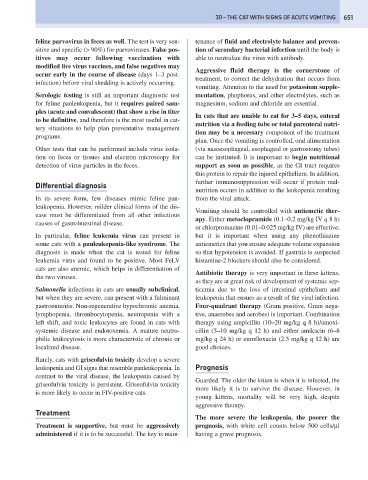Page 659 - Problem-Based Feline Medicine
P. 659
30 – THE CAT WITH SIGNS OF ACUTE VOMITING 651
feline parvovirus in feces as well. The test is very sen- tenance of fluid and electrolyte balance and preven-
sitive and specific (> 90%) for parvoviruses. False pos- tion of secondary bacterial infection until the body is
itives may occur following vaccination with able to neutralize the virus with antibody.
modified live virus vaccines, and false negatives may
Aggressive fluid therapy is the cornerstone of
occur early in the course of disease (days 1–3 post-
treatment, to correct the dehydration that occurs from
infection) before viral shedding is actively occurring.
vomiting. Attention to the need for potassium supple-
Serologic testing is still an important diagnostic test mentation, phophorus, and other electrolytes, such as
for feline panleukopenia, but it requires paired sam- magnesium, sodium and chloride are essential.
ples (acute and convalescent) that show a rise in titer
In cats that are unable to eat for 3–5 days, enteral
to be definitive, and therefore is the most useful in cat-
nutrition via a feeding tube or total parenteral nutri-
tery situations to help plan preventative management
tion may be a necessary component of the treatment
programs.
plan. Once the vomiting is controlled, oral alimentation
Other tests that can be performed include virus isola- (via nasoesophageal, esophageal or gastrostomy tubes)
tion on feces or tissues and electron microscopy for can be instituted. It is important to begin nutritional
detection of virus particles in the feces. support as soon as possible, as the GI tract requires
this protein to repair the injured epithelium. In addition,
further immunosuppression will occur if protein mal-
Differential diagnosis
nutrition occurs in addition to the leukopenia resulting
In its severe form, few diseases mimic feline pan- from the viral attack.
leukopenia. However, milder clinical forms of the dis-
Vomiting should be controlled with antiemetic ther-
ease must be differentiated from all other infectious
apy. Either metoclopramide (0.1–0.2 mg/kg IV q 8 h)
causes of gastrointestinal disease.
or chlorpromazine (0.01–0.025 mg/kg IV) are effective,
In particular, feline leukemia virus can present in but it is important when using any phenothiazine
some cats with a panleukopenia-like syndrome. The antiemetics that you ensure adequate volume expansion
diagnosis is made when the cat is tested for feline so that hypotension is avoided. If gastritis is suspected
leukemia virus and found to be positive. Most FeLV histamine-2 blockers should also be considered.
cats are also anemic, which helps in differentiation of
Antibiotic therapy is very important in these kittens,
the two viruses.
as they are at great risk of development of systemic sep-
Salmonella infections in cats are usually subclinical, ticemia due to the loss of intestinal epithelium and
but when they are severe, can present with a fulminant leukopenia that ensues as a result of the viral infection.
gastroenteritis. Non-regenerative hypochromic anemia, Four-quadrant therapy (Gram positive, Gram nega-
lymphopenia, thrombocytopenia, neutropenia with a tive, anaerobes and aerobes) is important. Combination
left shift, and toxic leukocytes are found in cats with therapy using ampicillin (10–20 mg/kg q 8 h)/amoxi-
systemic disease and endotoxemia. A mature neutro- cillin (5–10 mg/kg q 12 h) and either amikacin (6–8
philic leukocytosis is more characteristic of chronic or mg/kg q 24 h) or enrofloxacin (2.5 mg/kg q 12 h) are
localized disease. good choices.
Rarely, cats with griseofulvin toxicity develop a severe
leukopenia and GI signs that resemble panleukopenia. In Prognosis
contrast to the viral disease, the leukopenia caused by
Guarded. The older the kitten is when it is infected, the
griseofulvin toxicity is persistent. Griseofulvin toxicity
more likely it is to survive the disease. However, in
is more likely to occur in FIV-positive cats.
young kittens, mortality will be very high, despite
aggressive therapy.
Treatment
The more severe the leukopenia, the poorer the
Treatment is supportive, but must be aggressively prognosis, with white cell counts below 500 cells/μl
administered if it is to be successful. The key is main- having a grave prognosis.

